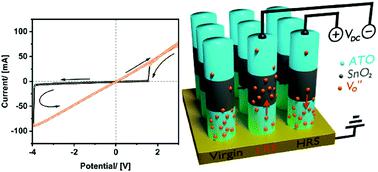Our official English website, www.x-mol.net, welcomes your
feedback! (Note: you will need to create a separate account there.)
Oxygen vacancy injection-induced resistive switching in combined mobile and static gradient doped tin oxide nanorods.
Nanoscale ( IF 5.8 ) Pub Date : 2020-08-27 , DOI: 10.1039/d0nr03734f Thomas Herzog 1 , Naomi Weitzel 2 , Sebastian Polarz 1
Nanoscale ( IF 5.8 ) Pub Date : 2020-08-27 , DOI: 10.1039/d0nr03734f Thomas Herzog 1 , Naomi Weitzel 2 , Sebastian Polarz 1
Affiliation

|
Resistive switching devices offer a great potential for advanced computing and data storage, including neuromorphic networks and random-access memory. State-of-the-art memristors are mostly realized by a three-layer structure, which is comprised of an active metal oxide layer sandwiched between two metal electrodes. Thus, there is always an interface involving two materials differing strongly in crystallographic and electronic properties. In this study, we present a resistive switching nanorod device based on a metal oxide sandwiched between two transparent conductive oxide electrodes. Thus, the system is characterized by a different, smooth interface offering new possibilities for increased energy efficiency and transparent electronics. Antimony-doped tin oxide (ATO) is used as an electrode material. The heavily doped ATO nanorods, exhibiting a good conductivity, are produced by a templated electrochemical deposition approach of alloy particles with subsequent thermal oxidation. The process enables precise control of the doping level within the nanorods and the formation of a doping level gradient. Electrical characterization reveals that a stronger gradient between heavily doped and undoped tin oxide within the nanorods results in a more rectifying character of the junction. Three-domain nanorods consisting of an undoped tin oxide segment in between two ATO segments are utilized to introduce memristive properties into the nanorod device. The resistive switching of these nanorods can be attributed to an oxygen vacancy doping gradient introduced during thermal oxidation. These vacancies are mobile within the tin oxide host structure and their injection from the ATO segment into the undoped tin oxide segment results in altered conductivity of the device, when an external bias is applied.
中文翻译:

混合移动和静态梯度掺杂的氧化锡纳米棒中的氧空位注入诱导的电阻转换。
电阻式开关设备为高级计算和数据存储(包括神经形态网络和随机存取存储器)提供了巨大潜力。最新的忆阻器主要由三层结构实现,该结构由夹在两个金属电极之间的活性金属氧化物层组成。因此,总是存在涉及两种材料的界面学在晶体学和电子性能方面差异很大的界面。在这项研究中,我们提出了一种基于夹在两个透明导电氧化物电极之间的金属氧化物的电阻开关纳米棒器件。因此,该系统的特征在于不同的平滑界面,为提高能效和透明电子设备提供了新的可能性。掺杂锑的氧化锡(ATO)用作电极材料。重掺杂的ATO纳米棒 通过模板化的合金粒子电化学沉积方法并随后进行热氧化,可生产出具有良好导电性的材料。该过程使得能够精确控制纳米棒内的掺杂水平并形成掺杂水平梯度。电学特征表明,纳米棒中重掺杂和未掺杂氧化锡之间的梯度更强,导致结的整流特性更强。由两个ATO片段之间的未掺杂氧化锡片段组成的三畴纳米棒可用于将忆阻特性引入纳米棒器件中。这些纳米棒的电阻转换可以归因于在热氧化期间引入的氧空位掺杂梯度。
更新日期:2020-09-18
中文翻译:

混合移动和静态梯度掺杂的氧化锡纳米棒中的氧空位注入诱导的电阻转换。
电阻式开关设备为高级计算和数据存储(包括神经形态网络和随机存取存储器)提供了巨大潜力。最新的忆阻器主要由三层结构实现,该结构由夹在两个金属电极之间的活性金属氧化物层组成。因此,总是存在涉及两种材料的界面学在晶体学和电子性能方面差异很大的界面。在这项研究中,我们提出了一种基于夹在两个透明导电氧化物电极之间的金属氧化物的电阻开关纳米棒器件。因此,该系统的特征在于不同的平滑界面,为提高能效和透明电子设备提供了新的可能性。掺杂锑的氧化锡(ATO)用作电极材料。重掺杂的ATO纳米棒 通过模板化的合金粒子电化学沉积方法并随后进行热氧化,可生产出具有良好导电性的材料。该过程使得能够精确控制纳米棒内的掺杂水平并形成掺杂水平梯度。电学特征表明,纳米棒中重掺杂和未掺杂氧化锡之间的梯度更强,导致结的整流特性更强。由两个ATO片段之间的未掺杂氧化锡片段组成的三畴纳米棒可用于将忆阻特性引入纳米棒器件中。这些纳米棒的电阻转换可以归因于在热氧化期间引入的氧空位掺杂梯度。











































 京公网安备 11010802027423号
京公网安备 11010802027423号